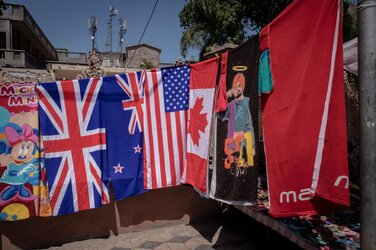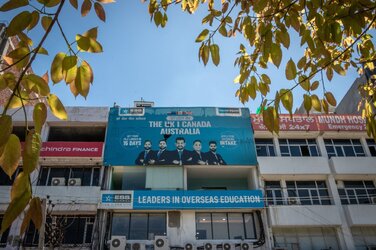The bustling city of Amritsar wears its aspirations for a better life in Canada on its sleeve. The streets are a vibrant tapestry of advertisements for immigration consultants and Maple Leaf flags flaunted on car windshields. Famed for the Golden Temple, the city is also known for its strong ties to the Punjabi diaspora in Canada, making it a hub for those seeking opportunities abroad.
But these opportunities are starting to dry up.
In December, the Canadian government made a change in financial requirements that dealt a heavy blow to the plans of thousands of would-be international students.
The increase in the guaranteed investment certificate needed to obtain a student visa, to $20,635 from $10,000 for international students, took effect in early January, alongside other measures in the last few months designed to limit the flow of foreign students.
The doubling of financial requirements — which is in addition to the first year of tuition and travel costs — is being felt most strongly in this part of India, and in particular has sparked apprehension among the young Punjabis dreaming of coming to Canada. Most of those we spoke to say it's an unbearable financial burden on their families.

[A reflection of the Maple Leaf on the dashboard as a car drives through Amritsar. Youth in Punjab frequently paint Canadian flags on their vehicles.]
For Dhandeep Singh, 22, a final-year engineering student, the desire to follow in his relative's footsteps and build a future in Canada is deeply ingrained. Standing at the window of a downtown restaurant near the central bus station, he glares at the cityscape as the sun sets, wondering what life is like on the other side of the world.
Like many youth from middle-class families, his desire to immigrate to Canada stems from a desire for a better life for him and his family. If a family invests in sending their child abroad, the financial support they get is actually more than double what many of them expect, he says, partly due to the Canadian dollar's strength vs. the rupee. It makes the family's life easy here.
As an only child it took him years to convince his family to support his decision to move to Canada, where he would study for a master's in engineering.
However, Singh's dreams were shattered when Canada doubled the cost-of-living payment or GIC amount last year, making it nearly impossible for him to afford the move. The policy change has left him with a sense of despair, and unsure of his future education plans.
Initially, after learning of the new financial requirement, his family suggested that he should look for more affordable study opportunities in other countries.
His family has since advised him to invest in a business in Punjab, or prepare for a government job, rather than moving abroad.
His family budgeted about $64,000 for the first year of his studies, excluding any part-time jobs. In India, it's common for parents to pay for the first year of tuition, the GIC, visa fee and travel expenses. The student is often expected to cover further expenses by getting a part-time job.
"Now our budget doesn’t meet the requirements, making it obvious that I can’t go to Canada", he says.

[Flags of the United Kingdom, Australia, the U.S. and Canada are for sale during the weekly Sunday market on Sultanwind Road in Amritsar, Punjab. Aspiring students often switch to other countries if they can't make it to Canada.]
Migration to foreign lands, particularly Canada, has a long history in Punjab. From the Sikh soldiers inducted into the British Indian Army travelling to Canada for training during the First World War, to the current generation seeking better educational and job opportunities, the allure of Canada has remained strong in the northern Indian state.
In 2022, Canada issued 548,350 new study permits. Indians accounted for 225,735, and a large chunk of whom are from Punjab. The next year, out of 682,060 permits, Indians accounted for 278,250.
Along with the availability of immigration pathways and job opportunities, several other factors have contributed to the significant increase in migration to Canada from the region: unemployment, corruption, political instability, and a lack of high-quality education at home. The Punjabi community that's already established in Canada also serves as a support system for new immigrants, making the transition smoother and more appealing.
In the first seven months of 2024, Canada issued 278,250 new permits. Indians accounted for 107,385. Under the new federal caps, Canada was to authorize 485,000 new study permits this year.
However, in recent years, high inflation and a housing crisis in Canada have posed a challenge for new immigrants trying to establish themselves in the country. Some international students and other immigrants have felt scapegoated or exploited. Meanwhile, surveys have also shown a shift in Canadians' once welcoming attitudes toward immigration.
As a result, Immigration Minister Marc Miller announced the change in the GIC amount required for student visa applicants. He said the goal is to ensure students have enough money for living expenses during their time in Canada.

[Prabhjot Singh, 25, sees corruption and unemployment in Punjab as important factors motivating him to consider moving to Canada.]
Prabhjot Singh, 25, another aspiring international student, holds mixed views on the new policy. He recognizes the importance of financial stability for students but also worries about implications for him and others with similar lower middle-class backgrounds.
"I don't have enough finances to relocate to Canada easily", he says, interviewed at Guru Nanak Dev University.
"Therefore, I need to convince my family to support me. But due to the change in GIC amount, many students from Punjab and other parts of India are feeling demotivated."
Prabhjot acknowledges that the Canadian government is dealing with high inflation, a housing crisis and other problems. However, for middle-class families and Indian students, this has shattered their dreams of moving to Canada. They need to switch their study-abroad dreams to some other country, take loans, or sell assets.
If he can't afford Canada, he is looking into studying in another country.
Before Miller's announcement, the GIC amount had been unchanged for years. The way it worked was a student would show proof of funds through the GIC when applying for a study permit; the money would later be credited to the student's account at a rate of $650 a month. Miller said the new amount would be adjusted every year.
According to a report by the ETV Bharat news network, coming to Canada as an international student had an upfront investment of about $24,000-$32,000 a year before the GIC change.
Some studies have calculated the average salary in Punjab as low as $300 a month.
Harmeet Kaur, 24, right, pictured with her college friend Navjot at Guru Nanak Dev University in Amritsar. Kaur sees Canada as a place where women can be safer and have much more freedom.
Some young Punjabi women have additional reasons for wanting to migrate. Harmeet Kaur, 24, sees Canada as a safe haven for women. She cites its progressive laws and strong support systems for immigrants, particularly employment and education equity, pay equity laws and promotion of inclusion in the workplace.
Kaur, who we spoke to at Guru Nanak Dev University in Amritsar, dreams of pursuing higher education and a career in Canada, away from the societal pressures and restrictions she faces in Punjab.
"I feel women consider moving abroad because there are no societal boundaries for females in western countries", she says.
"A lot of my female friends who have migrated often tell me that in Canada, there is no discrimination on the basis of gender", Kaur says. "However, it is always difficult to convince our parents, as they are strict towards females in regards to how we can survive alone and look for our safety in a new environment. But I believe it is much safer there than here."
(Whether Canada is as safe for female foreign students as Kaur believes is a matter of debate.)
In Punjabi society, women are often restricted in educational pursuits and ability to work outside the home. They face pressure to marry early.
Studies have also called attention to high rates of intimate partner violence.
The new financial rules have narrowed Kaur's options. Kaur, who is an undergrad in political science at Khalsa College in Amritsar, is planning to pursue a master's in Canada. She also feels that at her age, the longer she waits, the harder it might be to move abroad.
Kaur said when her female friends' families helped them study in Canada, it motivated her parents as well. "It is like, if they can do it, why can't you?"
"But with the rule change, they are left with no option, as they cannot afford to send us to Canada.", Kaur says. "If they seek a student loan at a local bank, then it will be restricted only to tuition fees, not the GIC amount."
Punjabi families have long made sacrifices to send their children abroad. Families have sold their assets, including land, houses, topsoil, gold, cars and tractors. According to a recent study by the Punjab Agricultural University, which examined data from 1990 until September 2022, aside from sending students abroad, families have spent up to $6,400 each on a work visa, spouse visa, or toward permanent residence.
Some also spent $40,000 to $50,000 to help migrants get smuggled into a country.
About 56% of households borrowed money to send their children abroad. The average amount borrowed by migrant households worked out to $5,000 per household. Of that, non-institutional borrowing made up 38.8%, and Institutional money formed 61.2% of total borrowing. Non-institutional borrowing was the remaining 38.8%, which can include loan sharks and family or friends. At the state level, about $2.3 billion were borrowed for the purpose of migration.
Until this year's changes, Canada had been greatly increasing its intake of foreign students for most of the past decade. In Punjab, demand for the visas is seen as a result of regional economic inequality. Shalini Sharma, a sociologist from Ludhiana, Punjab, predicts a rise in societal unrest and violence as an outcome of the GIC rule change.
"To meet a $10,000 GIC, the aspirants have done so much borrowing and selling of assets. If it is doubled, then you can imagine how much it will increase (pressure) in rural areas toward land selling, land topsoil selling, farm implement selling, and borrowing through non-institutional means."
"In the case of marginalized castes, their access will come only through non-institutional means like relatives", she says.
"In general, be it a big farmer or a small farmer, we have seen the trend in everyone. The recent agrarian crisis afflicting the state, fuelled by drought, climate change, high costs and government policies, is also making farming less viable as an option for young Punjabis."

The Canadian rule changes and decline in student visas issued have also affected another group of people: immigration consultants.
"Last year, we managed some 500 applications", says Nitin Chawla, a consultant based in Ludhiana. "This year, there were 20-30 applications."
Data from Immigration, Refugees and Citizenship Canada shows that Ottawa granted nearly 45,000 study permits to Indian students in January and February this year, and the number came down to just 4,210 in March.
This decline in student visa applications has raised concerns for consultants about their business prospects. "There is a big dip in the market", says Chawla, who estimated there are only five per cent of businesses left.
Despite the challenges, aspiring students like Dhandeep Singh, Prabhjot Singh and Harmeet Kaur are determined to push through and succeed. But so much uncertainty remains.
Whatever the effects in Canada, Sharma worries that in time, the changed Canadian policies will have a profound, even dangerous effect in Punjab. "Those who are unable to realize their dreams because of this change are going to impact the social fabric. There will be unrest, tensions, and depression, especially among the rural youth."





